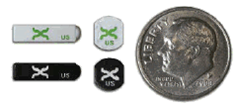The ZiuZ Inspector – or is it the Foresee Inspector – is an interesting system designed to inspect the contents of unit dose packages produced by high-speed unit dose packagers. I don’t think there’s much need for this in most acute care pharmacy operations here in the U.S. because we don’t unit dose enough tablets and/or capsules to make it worth while, but I do think it may have potential in some long-term care pharmacies using a central dispensing model. Who knows, that’s not really my area of expertise.
(more…)
Author: Jerry Fahrni
-
Cool Pharmacy Technology – ZiuZ Inspector
-
Don’t confuse Durezol and Durasal (S.A.L.A.D.)
PharmQD: “FDA is alerting pharmacists and other health care professionals of potential injury due to confusion between the FDA-approved eye medicine Durezol (difluprednate ophthalmic emulsion) 0.05% and the unapproved prescription topical wart remover Durasal (salicylic acid) 26%.
There has been one report of serious injury when a pharmacist mistakenly gave an eye surgery patient Durasal, the salicylic acid–containing wart remover, instead of the prescribed Durezol eye drops. Durezol is approved for treatment of inflammation and pain association with ocular surgery.â€
Seems like I’ve read about this mistake before. Being their typical efficient self, the FDA alert was issued on December 28, 2011, more than three months after ISMP alerted everyone.
Some things you can do to prevent stuff like this from happening include (taken from a Pharmacy Times article):
- Include both brand and generic names, along with indication, when prescribing look- or sound-alike drug names.
- Spell out drug names that have been confused when accepting telephone orders. Require staff to write down the prescription and then perform a read back (and spell back for drugs that are known to cause confusion) of the complete prescription for verification.
- Assign time to provide counseling to patients and/or caregivers, especially for new prescriptions.
-
The e-patient movement, panacea or barrier to care?
I haven’t really paid much attention to the e-patient movement, but recently it’s become a subject of interest.
I Googled “epatientâ€, and here’s what I found: “e-Patients are health consumers who use the Internet to gather information about a medical condition of particular interest to them, and who use electronic communication tools in coping with medical conditions The term encompasses both those who seek online guidance for their own ailments and the friends and family members who go online on their behalf. e-Patients report two effects of their online health research: “better health information and services, and different (but not always better) relationships with their doctors.”†This definition comes from Wikipedia. I’m not a big fan of Wikipedia, but in this case it seems appropriate.
(more…) -
Safety, privacy and UCSF Med Center’s failure to do the right thing
I am a UCSF School of Pharmacy alum. I consider UCSF Medical Center, along with many other people, to be one of the best medical centers in the country. And, UCSF Medical Center saved my mother’s life with a liver transplant earlier this year. However, I am frustrated with UCSF Medical Center this morning.
-
Metal RFID tags for surgical instruments
 The problem addressed by metal RFID of forgotten surgical tools, sponges and towels is a serious one. The Healthcare Informatics Company found in 2008 that in one out of every eight operations, surgical tools are not properly accounted for. Other statistics indicate such items are left inside a patient’s body in between 1 out of every 1,000 and 1 out of every 5,000 operations. When this happens, they can cause infections and require additional operations, putting a patient’s health at risk and costing a hospital time and money. Until now, hospital operating table personnel had to manually count each small item.
The problem addressed by metal RFID of forgotten surgical tools, sponges and towels is a serious one. The Healthcare Informatics Company found in 2008 that in one out of every eight operations, surgical tools are not properly accounted for. Other statistics indicate such items are left inside a patient’s body in between 1 out of every 1,000 and 1 out of every 5,000 operations. When this happens, they can cause infections and require additional operations, putting a patient’s health at risk and costing a hospital time and money. Until now, hospital operating table personnel had to manually count each small item.The solution comes from a new generation of small RFID tags. These new metal RFID tags are robust enough to be inserted into surgical instruments, towels and sponges at the time of manufacture and can be read from distances of up to two meters. However, they remain compatible with, and safe for the human body. Xerafy, a Hong Kong company specializing in this technology, has recently introduced a new range of such RFID metal tags. Now RFID for surgical instruments allows them to be tracked automatically, through the operation itself and even throughout sterilization and disposal.
Xerafy offers a couple of whitepapers on the subject worth reading. They can be found here.
-
Year end thoughts 2011
 2011 brought many new and exciting changes not only in my personal life, but in the world of pharmacy and technology as well. I’ve learned many new things, gained some new skills, made some new friends, explored the world of pharmacy more deeply, traveled more than ever before and discovered that I once again know nothing. I am excited to see what 2012 has to bring.
2011 brought many new and exciting changes not only in my personal life, but in the world of pharmacy and technology as well. I’ve learned many new things, gained some new skills, made some new friends, explored the world of pharmacy more deeply, traveled more than ever before and discovered that I once again know nothing. I am excited to see what 2012 has to bring. Below is a list of opinions I’ve gathered over the past 12 months. Some are pharmacy related, some are technology related, some are personal, and some are just random thoughts. If you don’t agree with my opinions that’s fine, but I don’t want to hear about it. On the other hand if you have something useful to add please feel free to leave a comment.
-
High-Alert Medications Involved in Wrong-Drug Errors [Article]
A recent article in Pharmacy Times outlines some interesting examples of Sound-Alike-Look-Alike-Drugs (SALAD) causing trouble in pharmacy. We’ve all seen them, and I’ve blogged about them before. Hydralazine and hydroxyzine represent a prototypical SALAD pair, but there are many others out there; ISMP’s list can be found here (PDF).
(more…) -
Merry Christmas 2011
And there were shepherds living out in the fields nearby, keeping watch of their flocks at night. An angel of the Lord appeared to them, and the glory of the Lord shone around them, and they were terrified. But the angel said to them, “Do not be afraid. I bring you good news of great joy that will for all the people. Today in the town of David a Savior has been born to you; he is Christ the Lord.
Luke 2:8-11
-
Prevalence of medication administration errors in two medical units with automated prescription and dispensing [Article]
From the Journal of the American Medical Informatics Association1. I was a little shocked by the number of errors, but as you can see in the abstract below, and in the title, the errors were during the administration phase of the medication use process. Seems a bit odd to look at medication errors during administration when talking about automated prescribing and dispensing. I’m sure there is an explanation in the full article. However that requires a subscription. Interesting nonetheless:
Abstract
Objective To identify the frequency of medication administration errors and their potential risk factors in units using a computerized prescription order entry program and profiled automated dispensing cabinets.Design Prospective observational study conducted within two clinical units of the Gastroenterology Department in a 1537-bed tertiary teaching hospital in Madrid (Spain).
Measurements Medication errors were measured using the disguised observation technique. Types of medication errors and their potential severity were described. The correlation between potential risk factors and medication errors was studied to identify potential causes.
Results In total, 2314 medication administrations to 73 patients were observed: 509 errors were recorded (22.0%)—68 (13.4%) in preparation and 441 (86.6%) in administration. The most frequent errors were use of wrong administration techniques (especially concerning food intake (13.9%)), wrong reconstitution/dilution (1.7%), omission (1.4%), and wrong infusion speed (1.2%). Errors were classified as no damage (95.7%), no damage but monitoring required (2.3%), and temporary damage (0.4%). Potential clinical severity could not be assessed in 1.6% of cases. The potential risk factors morning shift, evening shift, Anatomical Therapeutic Chemical medication class antacids, prokinetics, antibiotics and immunosuppressants, oral administration, and intravenous administration were associated with a higher risk of administration errors. No association was found with variables related to understaffing or nurse’s experience.
Conclusions Medication administration errors persist in units with automated prescription and dispensing. We identified a need to improve nurses’ working procedures and to implement a Clinical Decision Support tool that generates recommendations about scheduling according to dietary restrictions, preparation of medication before parenteral administration, and adequate infusion rates.
1. J Am Med Inform Assoc. 2012 Jan 1;19(1):72-8. Epub 2011 Sep 2.
